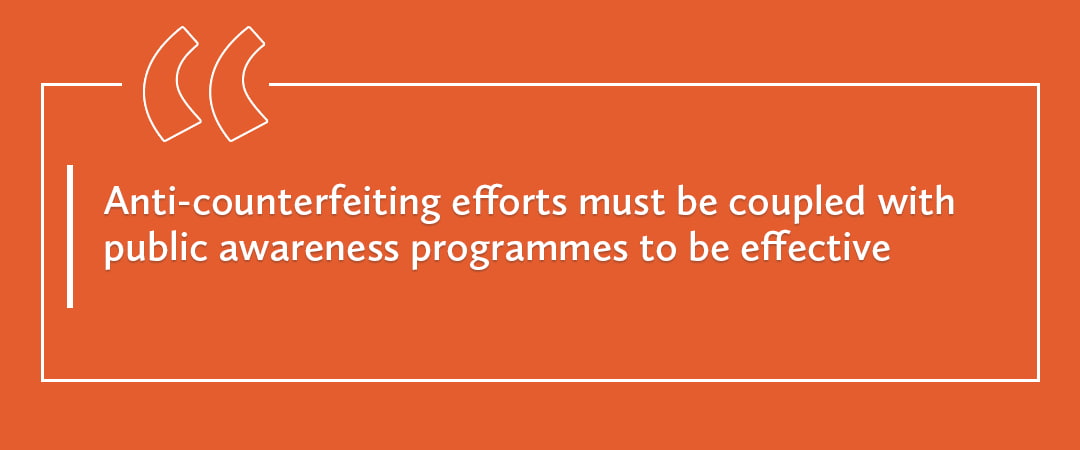Combatting counterfeiters is never easy, but often the very survival of quality enterprises is on the line. The stakes are high so the right strategies are key, write Ami Parikh and Bhavesh Haria, in-house counsel at Asian Paints
The malaise arising from counterfeiting is industry agnostic. All can be counterfeited, with the most affected sectors being fast-moving consumer goods (FMCG), pharma, tobacco, alcohol and currency.
In January 2023, the non-profit Authentication Solution Providers’ Association (ASPA) and the financial research company CRISIL released a report titled State of Counterfeiting in India 2022, presenting the findings of an independent survey that estimated about 25-30% of goods in India are counterfeit.

General Counsel, Head of Legal and Compliance
Asian Paints
Counterfeiters exploit the company’s existing reputation and flood retail markets with spurious products at knockoff rates. Loss of sales and brand dilution result. Legitimate businesses are left vulnerable to job turnover due to reduced earnings, a shrinking customer base and legal liability. Counterfeiting in the pharma and alcohol/beverage industries has had tragic consequences for unsuspecting consumers.
The cascading effect on the economy in the form of tax evasion, money laundering, and impact on public health and safety only worsens the scenario. A 2022 report by the Federation of Indian Chambers of Commerce and Industry (FICCI) put the estimated tax loss to the government due to illicit goods in five key industries at INR585.2 billion (USD7 billion) in FY 2019-20. The report further estimated the loss of 1.5 million legitimate jobs in these five industries due to illicit trade.
Counterfeiters remain unburdened by high manufacturing costs, or the need for innovation, quality standards or compliance controls. Aided by supply chain disruptions during covid–19 and burgeoning digital markets, counterfeiters now have alternate channels to peddle fake goods undetected.
Using social media platforms and fake websites, illicit sellers target a wider audience, often hijacking the brand owners’ marketing efforts to divert traffic. Many consumers, unmindful or uncaring of associated health and safety risks, are willing to buy low-cost fakes and lookalikes, either due to cost constraints, limited availability or social pressures. With low entry barriers and limited fear of enforcement, counterfeiters mushroom in every pocket of the country.
A definition

Senior Manager (Legal)
Asian Paints
According to section 28 of the Indian Penal Code (IPC) 1860: “A person is said to ‘counterfeit’ who causes one thing to resemble another thing, intending by means of that resemblance to practise deception, or knowing it to be likely that deception will thereby be practised.”
Fake products (particularly in FMCG) exist largely in three forms: (1) infringement, where lookalike products deceptively resemble established brand names and logos; (2) spurious products, where inferior or adulterated products have packaging identical to genuine products; and (3) grey imports, where products are imported for distribution without the brand owner’s authorisation, or products are sold that are barred in a particular territory due to their composition.
All of these leverage a company’s reputation as well as the consumer’s lack of awareness and desire for cheaper alternatives. This article treats infringement as a sub-set of counterfeiting for ease of reference.
Laws against counterfeiters
India has a fairly robust legal framework in place enabling product manufacturers to protect their intellectual property from counterfeiters, whether in the form of trademarks, patents, designs or copyright. Unlike for patents and designs, both trademark and copyright legislation allow for criminal prosecution. The protection of IP is also extended within other statutes such as Indian Penal Code, 1860, the Code of Criminal Procedure, 1973, and the Customs Act, 1962.
A sector-specific regulation like the Drugs and Cosmetics Act, 1940, has stringent punishment for counterfeiting. The Consumer Protection (E-commerce) Rules, 2020, placed responsibilities on marketplace e-commerce entities as well as sellers on the marketplace to ensure identification of the sellers.
Companies actively target counterfeiting activities by collaborating with private agencies and public enforcement authorities. Companies hire investigative agencies to scout hotbeds of criminal activities and generate leads.
Typically, once evidence of counterfeiting activity has been generated, a target is identified for further action. It is at the discretion of the legal team to decide the best course of action. Usually, in a lookalike case, companies prefer to file a trademark and copyright infringement suit in the district/high court. For cases involving spurious products, a criminal complaint may be lodged with the police under sections 51 and 63 of the Copyright Act, along with section 420 of the Indian Penal Code.
Courts appoint the court receiver (with suitable police protection) to conduct the raids and seize infringing products. Courts are also amenable to settlements, allowing the plaintiffs to recover damages and put an end to the litigation.
Courts have passed “John Doe” orders allowing companies to take action against unknown persons where there is a common cause of action, saving them from legal hassles of filing individual suits. Where a company apprehends a possible violation of its IP rights, a remedy such as the quia timet (because apprehension is feared) action allows injunctive relief before the wrong is committed.
Combatting counterfeits
With only a few cities possessing a dedicated IP cell within police stations, or IP benches within courts, it can be weeks or even months before a genuine business can obtain protective orders. Meanwhile, fraud is continuing unabated, resulting in reputational loss that is beyond the purview of financial compensation and cannot be substituted for, or compensated.
Apart from the overburdened court system in India, there’s many a slip between the cup and the lip when enforcing court orders for timely raids and seizures. For instance, police authorities demand copyright registrations for conducting criminal raids, even though the protection under law is not dependent on a registration certificate.
Co-operation from police authorities for raids can be difficult to solicit despite court orders at hand. Protracted execution of orders leaves scope for information leaks, forewarning counterfeiters, and such delays lay waste to the significant time and resources expended by companies towards investigations and court actions.
Even armed with favourable orders and timely execution, companies often discover that the seizure is just the tip of the iceberg and, after a short period of inactivity, the habitual counterfeiters resume their illicit trade. Since counterfeiters find ways to get back into business very quickly, many companies are left in a never-ending cat-and-mouse chase.
With a maximum punishment of up to three years, served after a long delay, the company might also find that the perpetrator has dropped off the radar and escaped prosecution.
While the menace of counterfeiting is indubitable, the cost benefit analysis of brand protection programmes is difficult to estimate. Cease and desist notices, investigations and raids can often feel like a never-ending cycle, with one infringement popping up as quickly as another is quashed.
Sizeable funds go towards court fees and legal fees, with costs continuing for the duration of the drawn-out litigation; these can be debilitating for smaller companies. Goods seized during raids are stored at the plaintiff’s cost, until they can be destroyed. Even making a dent in the sizeable problem of spurious products can feel like a long-term commitment, and brand owners who do not see bang for their buck can be quickly discouraged.
Countermeasures
While counterfeiting tends to be perceived as an external threat, the risk can also arise from internal factors like leakages in the supply chain, or weak controls on vendors. With a wider net to cast, companies need to tackle this problem with a slew of countermeasures across functions, rather than approaching it with a single solution.
Companies tend to dismiss small-time infringers as nuisances, allowing them to proliferate unchecked. By the time awareness sets in, the counterfeiting market has become too big to contain and the original manufacturer finds itself competing with the fraudster for market share.
When embarking on a brand protection programme, companies will need senior management buy-in so that dedicated resources and budgets are apportioned. It is also incumbent on the brand protection team to demonstrate the positive impact of defensive/offensive actions.
Courts are recognising the damage inflicted on legitimate business due to counterfeiting and are willing to pass stricter orders. The Supreme Court of India recently settled the legal position and held that section 63 of the Copyright Act, 1957, is a cognisable and non-bailable offence.
It is now possible, at the ad interim stage, to move an application for counterfeit goods to be seized and destroyed immediately without having to wait and store them until the final order. Courts are increasingly granting orders requiring infringers to disclose the names of their suppliers/persons in the supply chain, increasing the leads available to companies.
Companies can tap multiple channels such as customer complaints, distributor intelligence or sales teams for lead generation. With increased market intelligence, companies are now training their focus on the counterfeit supply chain to stop fake goods from even reaching the market.
There is increased investment in monitoring systems using AI to detect fraudulent online retailers and resorting to an offensive approach such as removal of listings/blocking of domain names. In recent instances, brand owners have stepped up vigilance when launching new products or brands.
Companies can fortify their supply chain with regular audits on vendors and zero tolerance policy for any counterfeiting activity. Leveraging technology for innovations in product tracking and packaging design can safeguard products against counterfeiting. Products containing radio-frequency identification (RFID)/security substrata, or packaging with micro text or invisible bar codes, allow for easy tracing and recognition of genuine products.
Companies can revamp packaging regularly, making it harder for counterfeiters to follow suit. With complete information flow between legal, sales and product teams, companies can improve their packaging and design solutions. Companies should ensure that their investigative agencies are trained to recognise genuine products using the inbuilt security and tracking features.
Anti-counterfeiting efforts must be coupled with public awareness programmes to be effective. The above-mentioned CRISIL-ASPA report showed that 31% of the respondents had knowingly purchased counterfeit products. Companies need to own the responsibility of continually educating consumers on the dangers of using fakes or lookalikes, as well as modes of identifying genuine products.
Companies can explore joint and collaborative efforts to combat counterfeiting, such as joint raid actions, sharing of best practices and advocacy. More stringent IP laws and increasing the capacity of the current enforcement agencies (with dedicated IP cells and IP benches) will allow for strong and swift action in counterfeit cases, giving much-needed impetus to private organisations to take protective action for their brands.
Conclusion
At the end of the day, a holistic approach to brand protection involves not just timely legal action but also vigilant monitoring of physical and online markets, building a robust supply chain, technology-led innovation in packaging, customer education and advocacy. Companies can analyse the wealth of data offered by these sources to strategically target the counterfeit market instead of a hit-and-miss approach.
Companies with a reputation of cracking down on illicit trade will not only instil confidence in genuine retailers, but also caution parties dealing with counterfeiters. It is high time that companies charge into the arena to ring-fence their brand instead of allowing their strategy to be dictated by the actions of counterfeiters.
Ami Parikh is general counsel of Asian Paints, heading legal and compliance. Bhavesh Haria is senior manager, legal, for Asian Paints. This article is for general information purposes only and is not intended to be used as a substitute for legal advice or professional advice.





























